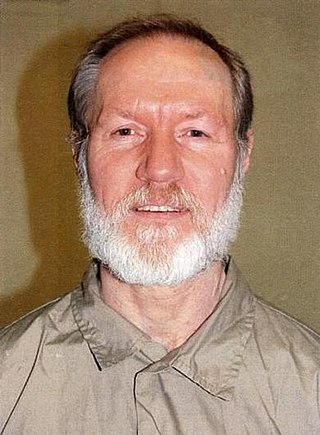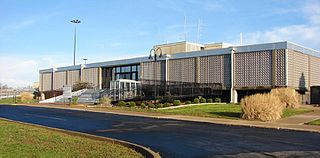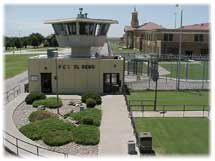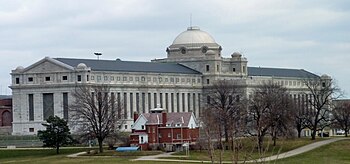
The United States Disciplinary Barracks (USDB), colloquially known as Leavenworth, is a military correctional facility located on Fort Leavenworth, a United States Army post in Kansas. It is one of two major prisons built on Fort Leavenworth property, the other is the military Midwest Joint Regional Correctional Facility, which opened on 5 October 2010. It reports to the United States Army Corrections Command and its commandant usually holds the rank of colonel.

The Federal Bureau of Prisons (BOP) is responsible for all Federal prisons and provide for the care, custody, and control of federal prisoners.

A super-maximum security (supermax) or administrative maximum (ADX) prison is a "control-unit" prison, or a unit within prisons, which represents the most secure level of custody in the prison systems of certain countries.
The Iowa State Penitentiary (ISP) is an Iowa Department of Corrections maximum security prison for men located in the Lee County, Iowa, community of Fort Madison. This facility should not be confused with the Historical Iowa State Penitentiary, which was shut down in 2015 after being open for 175 years. The HISP itself was a 550-person maximum security unit. Also on the complex was a John Bennett Correctional Center - a 169-person medium security unit. The HISP included two minimum-security farms with about 170 people who were located within a few miles of the main complex. The complex also had a ten-person multiple care unit, and a 120-bed special-needs unit for prisoners with mental illness or other diseases that require special medical care. In total, there were about 950 inmates and 510 staff members.

The Federal Correctional Institution, Thomson, formerly United States Penitentiary, Thomson and Thomson Correctional Center, is a low-security federal prison located in Thomson, Illinois. It has an area of about 146 acres (59 ha) and comprises 15 buildings. The facility is enclosed by a 15-foot (4.6 m), 7000 volt electric fence surrounded by an additional 12-foot (3.7 m) exterior fence covered with razor wire. Thomson has eight cellhouses with a rated capacity of 2,100 beds—1,900 high-security SMU beds and 200 minimum-security beds at the onsite camp—and according to BOP officials, the potential to use some of its high-security rated capacity to house up to 400 ADX inmates. From its completion in 2001 to 2006, it remained empty. By 2009, only the minimum-security section housed prisoners.

Thomas Edward Silverstein was an American criminal who spent the last 42 years of his life in prison after being convicted of four separate murders while imprisoned for armed robbery, one of which was overturned. Silverstein spent the last 36 years of his life in solitary confinement for killing corrections officer Merle Clutts at the Marion Penitentiary in Illinois. Prison authorities described him as a brutal killer and a former leader of the Aryan Brotherhood prison gang. Silverstein maintained that the dehumanizing conditions inside the prison system contributed to the three murders he committed. He was the longest-held prisoner in solitary confinement within the Bureau of Prisons at the time of his death. Correctional officers refused to talk to Silverstein out of respect for Clutts.

The United States Penitentiary, Atlanta is a low-security United States federal prison for male inmates in Atlanta, Georgia. It is operated by the Federal Bureau of Prisons, a division of the United States Department of Justice. The facility also has a detention center for pretrial and holdover inmates, and a satellite prison camp for minimum-security male inmates.

The United States Penitentiary, Marion is a large medium-security United States federal prison for male and female inmates in Southern Precinct, unincorporated Williamson County, Illinois. It is operated by the Federal Bureau of Prisons, a division of the United States Department of Justice. The facility also has an adjacent satellite prison camp that houses minimum security male offenders.

The Federal Correctional Institution, Lewisburg is a medium-security United States federal prison in Kelly Township, Pennsylvania, for male inmates. It is operated by the Federal Bureau of Prisons, a division of the United States Department of Justice. An adjacent satellite prison camp houses minimum-security male offenders.

The United States Penitentiary, Terre Haute is a high-security United States federal prison for male inmates in Terre Haute, Indiana. It is part of the Federal Correctional Complex, Terre Haute and is operated by the Federal Bureau of Prisons, a division of the United States Department of Justice. USP Terre Haute houses a Special Confinement Unit for male federal inmates who have been sentenced to death as well as the federal execution chamber. Most inmates sentenced to death by the U.S. federal government are housed in USP Terre Haute prior to execution, with few exceptions. FCC Terre Haute is located in the city of Terre Haute, 70 miles (110 km) west of Indianapolis.

Lansing Correctional Facility (LCF) is a state prison operated by the Kansas Department of Corrections. LCF is located in Lansing, Kansas, in Leavenworth County. LCF, along with the Federal Bureau of Prison's United States Penitentiary, Leavenworth, the United States Army Corrections Command's United States Disciplinary Barracks, and Midwest Joint Regional Correctional Facility in Fort Leavenworth are the four major prisons that give the Leavenworth area its reputation as a corrections center.
The Atlanta prison riots were a series of prison riots that occurred at the U.S. Penitentiary in Atlanta, Georgia, United States in November 1987. The riot coincided with a similar riot at the Federal Detention Center in Oakdale, Louisiana.

The United States Penitentiary, Hazelton is a high-security United States federal prison for male inmates in West Virginia. The high-security facility has earned the nickname "Misery Mountain" by the inmates who are incarcerated there. It is operated by the Federal Bureau of Prisons, a division of the United States Department of Justice. The facility has a satellite prison camp for minimum-security male offenders.

The Montana State Prison is a men's correctional facility of the Montana Department of Corrections in unincorporated Powell County, Montana, about 3.5 miles (5.6 km) west of Deer Lodge. The current facility was constructed between 1974 and 1979 in response to the continued degeneration of the original facility located in downtown Deer Lodge.
The United States Army Corrections Command (ACC) exercises command and control and operational oversight for policy, programming, resourcing, and support of Army Corrections System (ACS) facilities and TDA elements worldwide.

Federal Correctional Institution, El Reno is a medium-security United States federal prison for male inmates in Oklahoma. It is operated by the Federal Bureau of Prisons (BOP), a division of the United States Department of Justice. The facility has an adjacent satellite camp for minimum-security male offenders.

The Federal Correctional Complex, Coleman is a United States federal prison complex for male inmates in unincorporated Sumter County, Florida, near Wildwood. It is operated by the Federal Bureau of Prisons (BOP), a division of the United States Department of Justice.

The United States Penitentiary, Victorville is a high-security United States federal prison for male inmates in California. It is part of the Federal Correctional Complex, Victorville and is operated by the Federal Bureau of Prisons, a division of the United States Department of Justice.
The Leavenworth Detention Center was a privately run maximum-security federal prison located in Leavenworth, Kansas. The facility was owned and operated by CoreCivic formerly named Corrections Corporation of America under contract with the United States Marshals Service.


















